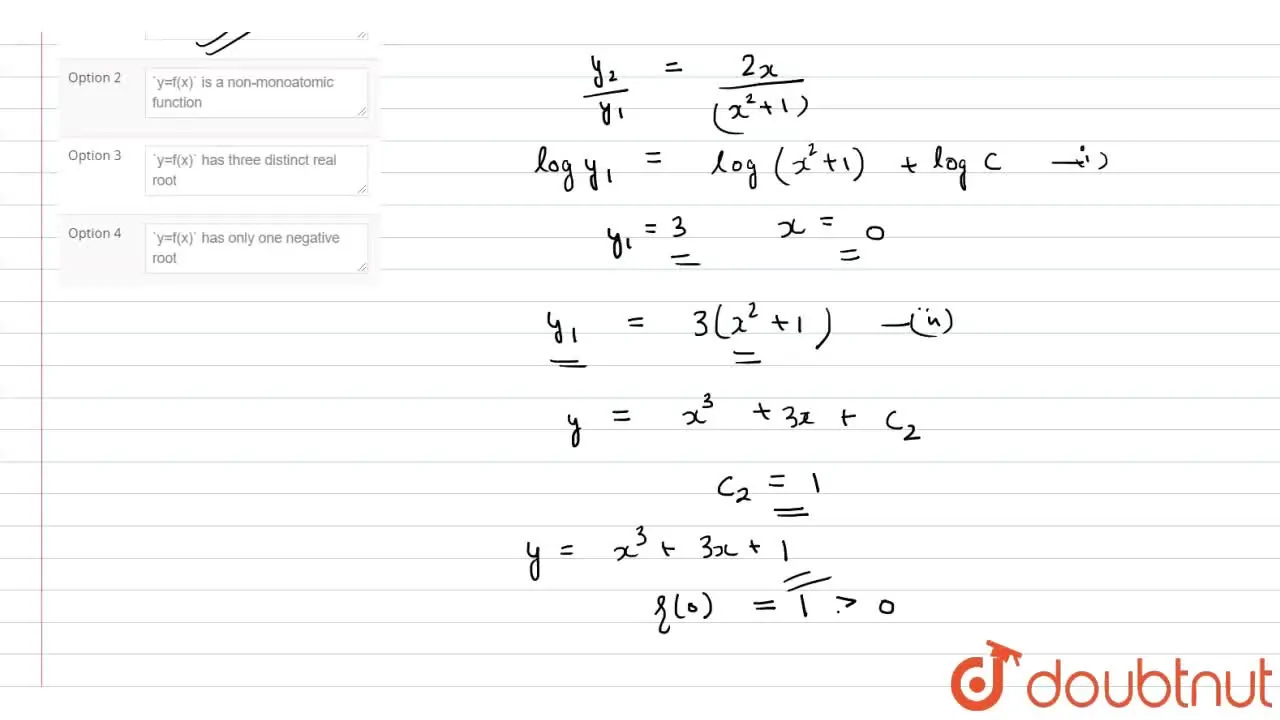The equation of the curve satisfying the differential equation passing through the point (0,1) and having slope of tangent at as 3 (where and represent 2nd and 1st order derivative), then (a) (g) is a strictly increasing function (h) (n) is a non-monotonic function (o) (u) has a three distinct real roots (v) (bb) has only one negative root.
is a strictly increasing function
is a non-monoatomic function
has three distinct real root
has only one negative root
The correct Answer is:A, D
The given differential equation is
or
Integrating both sides, we get
………(1)
It is given that at x=0
Putting at
Substituting the value of C in (1), we obtain
..............(2)
Integrating both sides w.r.t to x, we get
This passes through the point (0,1). Therefore, 1
Hence, the required equation of the curve is
Obviously, is it strictly increasing from equation (2).
Also, . Then the only root is negative.
Related Playlists
- BOOK - CENGAGE ENGLISHCHAPTER - DIFFERENTIAL EQUATIONSEXERCISE - Linked Comprehension types21videos
DIFFERENTIAL EQUATIONS
- BOOK - CENGAGE ENGLISHCHAPTER - DIFFERENTIAL EQUATIONSEXERCISE - Numerical value type17videos
DIFFERENTIAL EQUATIONS
- BOOK - CENGAGE ENGLISHCHAPTER - DIFFERENTIAL EQUATIONSEXERCISE - SINGLE CORRECT ANSWER TYPES74videos
DIFFERENTIAL EQUATIONS
- BOOK - CENGAGE ENGLISHCHAPTER - DIFFERENT PRODUCTS OF VECTORS AND THEIR GEOMETRICAL APPLICATIONS EXERCISE - Multiple correct answers type11videos
DIFFERENT PRODUCTS OF VECTORS AND THEIR GEOMETRICAL APPLICATIONS
- BOOK - CENGAGE ENGLISHCHAPTER - DIFFERENTIATIONEXERCISE - Archives14videos
DIFFERENTIATION
Similar Questions
The equation of the curve satisfying the differential equation Y2(x2+1)=4xy1, passing through the point (0, – 4) and having slope of tangent at x = 0 as 4 is:
View SolutionThe equation of the curve satisfying the differential equation y(x+y3)dx=x(y3−x)dy and passing through the point (1,1) is
View SolutionThe equation of the curve satisfying the differential equation y2(x2+1)=2xy passing through the point (0,1) and having slope of tangnet at x=0 as 3, is (Here y=dydxandy2=d2ydx2)
View SolutionThe equation of the curve satisfying the differential equation y2(x2+1)=2xy1 passing through the point (0,1) and having slope of tangent at x=0 as 3 (where y2 and y1 represent 2nd and 1st order derivative), then (a)y=f(x) is a strictly increasing function (b)y=f(x) is a non-monotonic function (c)y=f(x)) has a three distinct real roots (d)y=f(x) has only one negative root.
View SolutionThe equation of the curve satisfying the differential equation dydx+yx2=1x2 and passing through (12,e2+1) is
View SolutionA curve y=f(x) satisfy the differential equation (1+x2)dydx+2yx=4x2 and passes through the origin.
The function y=f(x)View SolutionThe equation of the curve whose slope is given by dydx=2yx;x>0, y>0 and which passes through the point (1,1) is
View SolutionThe equation of the curve passing through the point (1,1) and satisfying the differential equation dydx=x+2y−3y−2x+1 is
View SolutionFind the equation of a curve passing through (1,1) and whose slope of tangent at a point (x, y) is −xy.
View SolutionIf y=f(x) satisfy the differential equation dydx+yx=x2,f(1)=1, then value of f(3) equals:
View Solution


